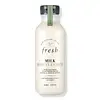What's inside
What's inside
 Key Ingredients
Key Ingredients

 Benefits
Benefits

 Concerns
Concerns

 Ingredients Side-by-side
Ingredients Side-by-side

Water
Skin ConditioningDisodium Cocoyl Glutamate
CleansingCoco-Betaine
CleansingGlycerin
HumectantSodium Cocoyl Isethionate
CleansingCitric Acid
BufferingDecyl Glucoside
CleansingSodium Citrate
BufferingCetearyl Alcohol
EmollientButyrospermum Parkii Butter
Skin ConditioningOlea Europaea Fruit Oil
MaskingCentella Asiatica Extract
CleansingLinum Usitatissimum Seed Extract
PerfumingLinum Usitatissimum Seed Oil
PerfumingHydrolyzed Rice Bran Protein
Skin ConditioningTocopherol
AntioxidantParfum
MaskingSodium Chloride
MaskingXanthan Gum
EmulsifyingCarrageenan
Caprylyl Glycol
EmollientCoconut Acid
CleansingGuar Hydroxypropyltrimonium Chloride
Skin ConditioningNiacinamide
SmoothingSodium Hyaluronate
HumectantPentaerythrityl Tetra-Di-T-Butyl Hydroxyhydrocinnamate
AntioxidantPotassium Sorbate
PreservativeSodium Benzoate
MaskingSorbic Acid
PreservativeWater, Disodium Cocoyl Glutamate, Coco-Betaine, Glycerin, Sodium Cocoyl Isethionate, Citric Acid, Decyl Glucoside, Sodium Citrate, Cetearyl Alcohol, Butyrospermum Parkii Butter, Olea Europaea Fruit Oil, Centella Asiatica Extract, Linum Usitatissimum Seed Extract, Linum Usitatissimum Seed Oil, Hydrolyzed Rice Bran Protein, Tocopherol, Parfum, Sodium Chloride, Xanthan Gum, Carrageenan, Caprylyl Glycol, Coconut Acid, Guar Hydroxypropyltrimonium Chloride, Niacinamide, Sodium Hyaluronate, Pentaerythrityl Tetra-Di-T-Butyl Hydroxyhydrocinnamate, Potassium Sorbate, Sodium Benzoate, Sorbic Acid
Lavandula Angustifolia Oil
MaskingRosin
Urtica Dioica
Prunus Amygdalus Dulcis Oil
Skin ConditioningSimmondsia Chinensis Seed Oil
EmollientPersea Gratissima Oil
Skin ConditioningMacadamia Ternifolia Seed Oil
EmollientButyrospermum Parkii Butter
Skin ConditioningSqualane
EmollientHydrolyzed Barley Protein
Skin ConditioningDecyl Glucoside
CleansingSorbitan Olivate
EmulsifyingTocopherol
AntioxidantLecithin
EmollientAllantoin
Skin ConditioningRosa Canina Fruit Oil
EmollientOenothera Biennis Oil
EmollientSymphytum Officinale Leaf Extract
Skin ConditioningDaucus Carota Sativa Seed Oil
EmollientChamomilla Vulgaris Extract
Skin ProtectingAnt Egg Oil Extract
Hydrolyzed Oat Flour
Skin ConditioningCyamopsis Tetragonoloba Gum
Emulsion StabilisingXanthan Gum
EmulsifyingCitric Acid
BufferingAlgae Extract
EmollientLeuconostoc/Radish Root Ferment Filtrate
AntimicrobialLavandula Angustifolia Oil, Rosin, Urtica Dioica, Prunus Amygdalus Dulcis Oil, Simmondsia Chinensis Seed Oil, Persea Gratissima Oil, Macadamia Ternifolia Seed Oil, Butyrospermum Parkii Butter, Squalane, Hydrolyzed Barley Protein, Decyl Glucoside, Sorbitan Olivate, Tocopherol, Lecithin, Allantoin, Rosa Canina Fruit Oil, Oenothera Biennis Oil, Symphytum Officinale Leaf Extract, Daucus Carota Sativa Seed Oil, Chamomilla Vulgaris Extract, Ant Egg Oil Extract, Hydrolyzed Oat Flour, Cyamopsis Tetragonoloba Gum, Xanthan Gum, Citric Acid, Algae Extract, Leuconostoc/Radish Root Ferment Filtrate
 Reviews
Reviews

Alternatives
Ingredients Explained
These ingredients are found in both products.
Ingredients higher up in an ingredient list are typically present in a larger amount.
This ingredient is also known as shea butter. It is an effective skin hydrator and emollient.
Emollients help soothe and soften your skin. It does this by creating a protective film on your skin. This barrier helps trap moisture and keeps your skin hydrated. Emollients may be effective at treating dry or itchy skin.
Shea butter is rich in antioxidants. Antioxidants help fight free-radicals, or molecules that may harm the body. It is also full of fatty acids including stearic acid and linoleic acid. These acids help replenish the skin and keep skin moisturized.
While Shea Butter has an SPF rating of about 3-4, it is not a sunscreen replacement.
Shea butter may not be fungal acne safe. We recommend speaking with a professional if you have any concerns.
Learn more about Butyrospermum Parkii ButterCitric Acid is an alpha hydroxy acid (AHA) naturally found in citrus fruits like oranges, lemons, and limes.
Like other AHAs, citric acid can exfoliate skin by breaking down the bonds that hold dead skin cells together. This helps reveal smoother and brighter skin underneath.
However, this exfoliating effect only happens at high concentrations (20%) which can be hard to find in cosmetic products.
Due to this, citric acid is usually included in small amounts as a pH adjuster. This helps keep products slightly more acidic and compatible with skin's natural pH.
In skincare formulas, citric acid can:
While it can provide some skin benefits, research shows lactic acid and glycolic acid are generally more effective and less irritating exfoliants.
Most citric acid used in skincare today is made by fermenting sugars (usually from molasses). This synthetic version is identical to the natural citrus form but easier to stabilize and use in formulations.
Read more about some other popular AHA's here:
Learn more about Citric AcidDecyl Glucoside is a glucose-based surfactant and emulsion stabilizer. It is created by reacting glucose with the fatty acids from plants.
Surfactants help clean the skin by trapping oil, sebum, and dirt to be washed away. As an emulsion stabilizer, it stabilizes the ingredients in a product by preventing them from separating.
This ingredient is biodegradable and non-toxic. This ingredient is commonly found in baby shampoos.
Decyl Glucoside is sometimes used to stabilize the UV filter Tinosorb.
Learn more about Decyl GlucosideTocopherol (also known as Vitamin E) is a common antioxidant used to help protect the skin from free-radicals and strengthen the skin barrier. It's also fat soluble - this means our skin is great at absorbing it.
Vitamin E also helps keep your natural skin lipids healthy. Your lipid skin barrier naturally consists of lipids, ceramides, and fatty acids. Vitamin E offers extra protection for your skin’s lipid barrier, keeping your skin healthy and nourished.
Another benefit is a bit of UV protection. Vitamin E helps reduce the damage caused by UVB rays. (It should not replace your sunscreen). Combining it with Vitamin C can decrease sunburned cells and hyperpigmentation after UV exposure.
You might have noticed Vitamin E + C often paired together. This is because it is great at stabilizing Vitamin C. Using the two together helps increase the effectiveness of both ingredients.
There are often claims that Vitamin E can reduce/prevent scarring, but these claims haven't been confirmed by scientific research.
Learn more about TocopherolXanthan gum is used as a stabilizer and thickener within cosmetic products. It helps give products a sticky, thick feeling - preventing them from being too runny.
On the technical side of things, xanthan gum is a polysaccharide - a combination consisting of multiple sugar molecules bonded together.
Xanthan gum is a pretty common and great ingredient. It is a natural, non-toxic, non-irritating ingredient that is also commonly used in food products.
Learn more about Xanthan Gum